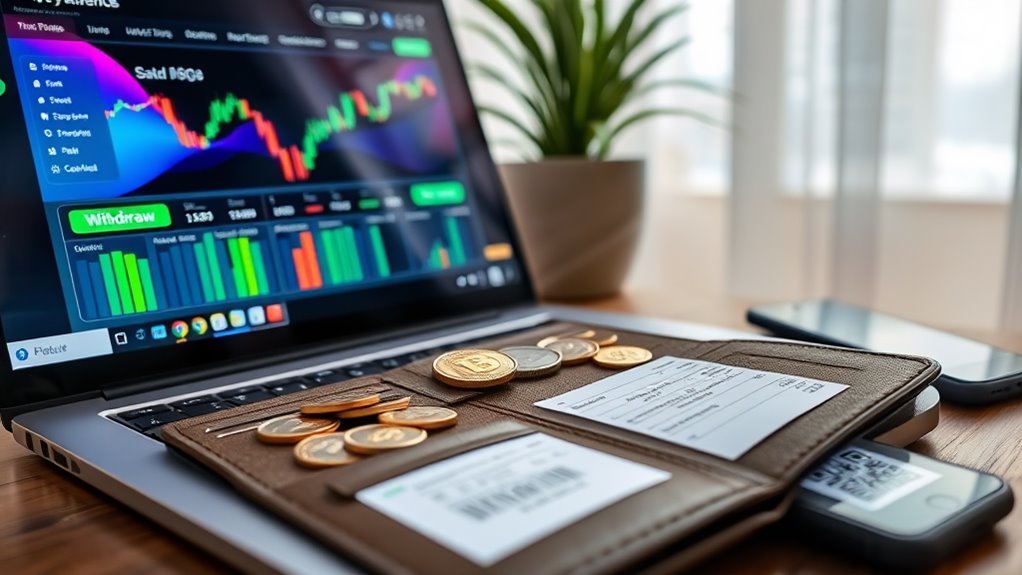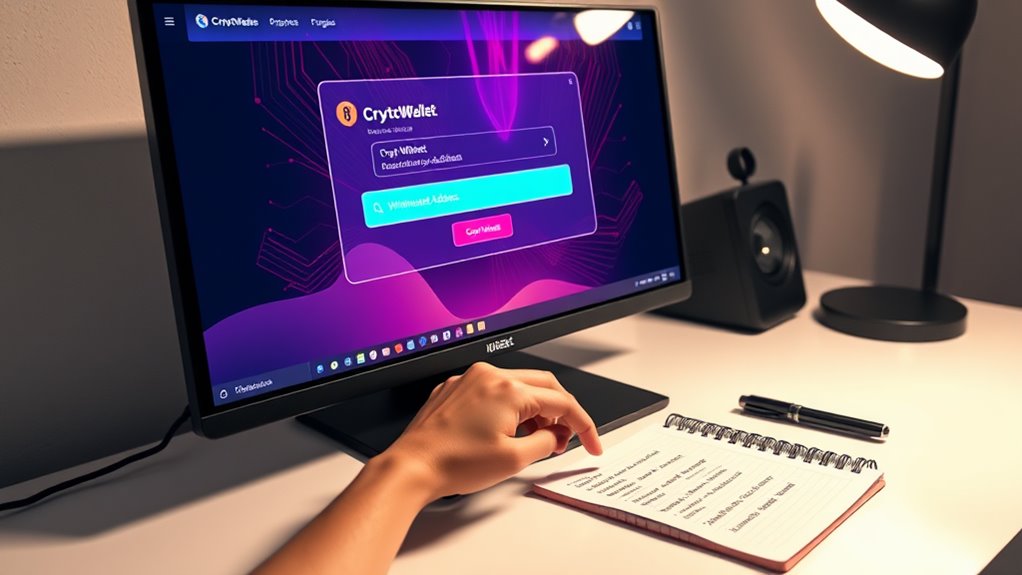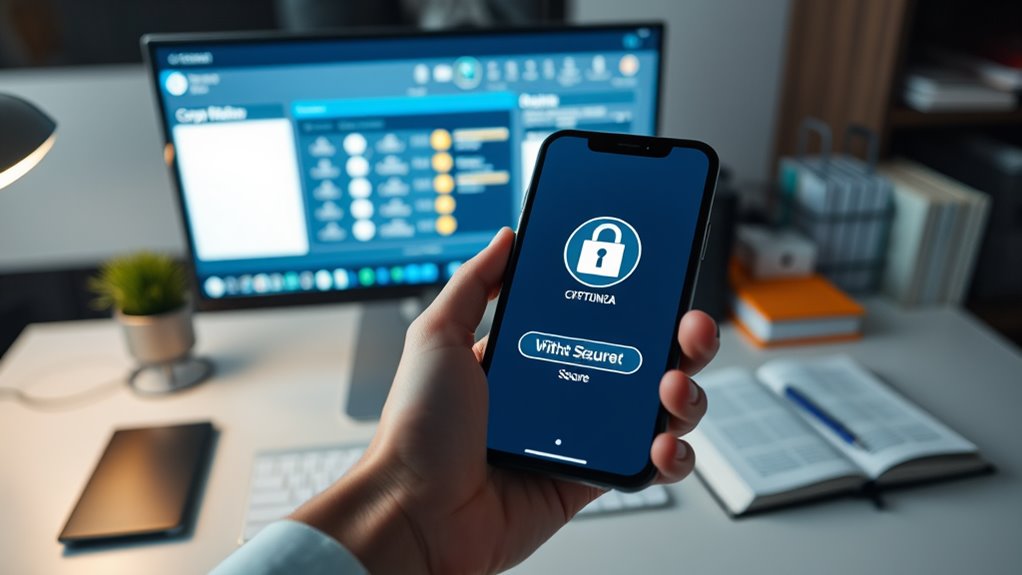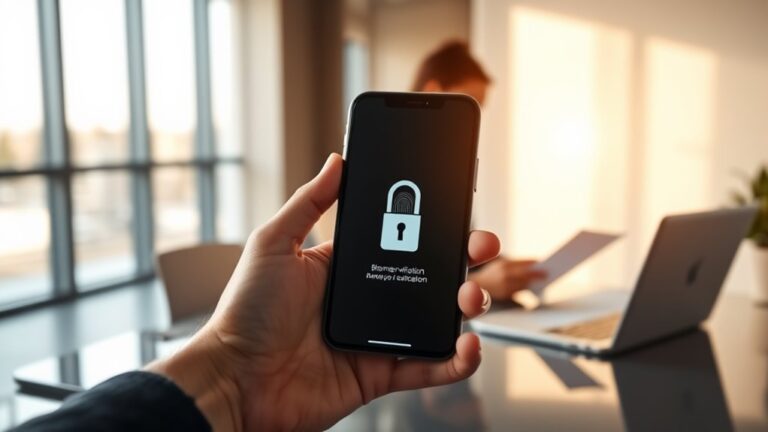
ApplicationRecord: : How to Withdraw Crypto to a Wallet: A Step-by-Step Guide”.
To withdraw cryptocurrency to an external wallet, users must first guarantee sufficient funds and set up a compatible wallet. Next, navigate to the withdrawal section in the crypto platform, select the desired cryptocurrency, and enter the destination wallet address. Enable security features like address whitelisting and two-factor authentication before confirming the transaction. After verification, track the withdrawal status through transaction history or blockchain explorers. The following guide explores each step in thorough detail.
Key Takeaways
- Ensure your external wallet address is properly configured and supports the cryptocurrency you’re withdrawing.
- Access the withdrawal process through the “Accounts” section and select the specific cryptocurrency to withdraw.
- Enter or select a properly formatted destination wallet address to avoid fund loss.
- Confirm withdrawals using passcode or biometric authentication, with additional 2FA on untrusted devices.
- Track your withdrawal in the “Transaction History” section and monitor blockchain confirmations using transaction explorers.
Understanding Crypto Withdrawal Prerequisites

Before initiating a cryptocurrency withdrawal, users must confirm several key prerequisites are in place to facilitate a smooth transfer process.
The most fundamental requirement is having sufficient funds in the account, including enough to cover both the withdrawal amount and associated transaction fees.
Users need a properly configured external wallet address that supports the specific cryptocurrency being transferred.
Ensure your withdrawal destination is compatible with your chosen cryptocurrency to prevent irretrievable fund loss.
Each blockchain network imposes different fee structures, which vary based on network congestion and the exchange’s policies. Additionally, exchanges typically establish minimum withdrawal thresholds to guarantee transactions remain economically viable given the associated network costs.
Transaction processing times differ markedly across cryptocurrencies, with some completing within minutes while others may take hours.
Users should account for these variables when planning withdrawals, especially for time-sensitive transactions. Furthermore, it is wise to choose a reputable exchange to ensure the security of your funds during the conversion process.
Setting Up Your External Wallet

Every cryptocurrency user requires a secure external wallet to properly store and manage digital assets outside of exchanges. The setup process varies depending on whether you choose a software wallet for daily transactions or a hardware wallet for long-term storage.
For software (hot) wallets, users should select a reputable provider, download the application from official sources, create an account, enable security features like two-factor authentication, and then fund the wallet.
Hardware wallet setup involves purchasing directly from manufacturers, installing official software, creating a secure environment free from malware, transferring assets, and storing the device safely.
When selecting any wallet, consider key features such as security protocols, multi-currency support, user interface simplicity, integration capabilities with exchanges, and available customer support channels. Additionally, popular options like hardware wallets offer maximum security for long-term storage, making them a preferred choice for many users.
Navigating the Crypto.com Withdrawal Interface

The Crypto.com withdrawal interface presents a logical sequence of screens that guide users through the transfer process.
Users must first select the specific cryptocurrency they wish to withdraw from their available assets, paying attention to the minimum withdrawal amounts and associated network fees.
After asset selection, entering or selecting a properly formatted destination wallet address becomes critical, as incorrectly entered addresses may result in permanent loss of funds.
Navigating Withdrawal Screens
Successful navigation of the Crypto.com withdrawal interface requires familiarity with several key sections of the app. Users must first tap “Accounts” from the home screen to view all available wallets. From there, selecting either “Fiat Wallet” or the appropriate crypto asset initiates the withdrawal process.
To withdraw cryptocurrency to an external wallet, users select “External Wallet” and choose a whitelisted address. The app requires confirmation through passcode or biometric authentication, with additional 2FA verification on untrusted devices.
For fiat withdrawals, users must have previously linked a bank account and selected a supported transfer method like ACH for USD transactions.
Throughout the process, users can track their withdrawals in the “Transaction History” section, where they’ll also find transaction IDs for verification on blockchain explorers when applicable. Additionally, it’s crucial to implement multi-factor authentication to enhance security during the withdrawal process.
Selecting Crypto Assets
Once withdrawal procedures are understood, users must navigate the process of selecting which cryptocurrency to transfer from their Crypto.com account.
The “Accounts” tab in the app provides access to the Crypto Wallet section, where all available assets are displayed with current balances and daily price movements.
When choosing which cryptocurrency to withdraw, users should consider several factors: network transaction fees, market volatility, regulatory constraints in their jurisdiction, and the liquidity of the asset.
Portfolio allocation views help users make informed decisions based on their current holdings.
After selecting a specific cryptocurrency by tapping on it, users will need to choose the appropriate blockchain network for their transaction.
Before confirming, it is crucial to verify that the destination wallet is compatible with both the selected asset and network to guarantee successful transfer. Additionally, users should prioritize exchanges with strong security features to protect their assets during the withdrawal process.
Destination Address Setup
Setting up an accurate destination address represents the most critical step in the crypto withdrawal process, as errors can result in permanent loss of funds. Users must first access their Crypto.com account, navigate to “Accounts,” and locate the “Crypto Wallet” section. After tapping “Transfer” followed by “Withdraw,” select “External Wallet” to initiate the process.
| Step | Action | Security Feature |
|---|---|---|
| 1 | Access “Accounts” section | Verification required |
| 2 | Tap “+” to add new address | Address whitelisting |
| 3 | Enter wallet details | Device authentication |
| 4 | Select blockchain network | Network verification |
| 5 | Complete verification | 24-hour security lock |
Adding a new wallet address requires verification through passkey or 2FA authentication methods. For enhanced security, a 24-hour withdrawal lock may be applied to newly whitelisted addresses. Ensuring the accuracy of this destination address is crucial, as crypto wallets serve as the means to access and manage digital assets on the blockchain.
Implementing Address Whitelisting for Added Security

Address whitelisting serves as a critical security feature that restricts cryptocurrency withdrawals to pre-approved wallet addresses, protecting users from unauthorized transfers and phishing attempts.
Users can establish their whitelist by adding trusted addresses through their exchange’s security settings, often requiring two-factor authentication for verification.
Maintaining an updated list of approved withdrawal destinations not only reduces the risk of human error during transactions but also supports compliance with regulatory standards across different jurisdictions. Additionally, utilizing hardware wallets can further enhance the security of these whitelisted addresses by providing a secure environment for managing private keys.
Address Whitelisting Basics
When security becomes paramount in cryptocurrency management, address whitelisting emerges as an essential protective measure. This security feature restricts withdrawals exclusively to pre-approved cryptocurrency addresses, effectively eliminating unauthorized transactions.
Whitelisting operates through verification techniques like the “Satoshi test,” where tiny transactions confirm address ownership. Beyond security enhancement, this practice supports compliance with Anti-Money Laundering (AML) and Know Your Customer (KYC) regulations by ensuring funds only move to verified wallets.
Even if an account becomes compromised, whitelisted addresses prevent rogue transfers, adding a significant layer of protection. For organizations, whitelisting simplifies auditing processes by creating a transparent, pre-verified transaction trail. Additionally, using whitelisting alongside other security measures, such as enhancing security measures, can further safeguard your assets against potential threats.
This systematic approach to transaction management transforms potentially vulnerable withdrawal processes into structured, secure operations with minimal vulnerability to both external attacks and internal misuse.
Managing Trusted Addresses
Why do cryptocurrency enthusiasts increasingly turn to address whitelisting as their security method of choice? This feature restricts withdrawals to pre-approved addresses only, markedly reducing the risk of unauthorized transfers.
When implemented properly, whitelisting creates a protective barrier against potential attackers who might gain access to an account. Most platforms require two-factor authentication before adding or modifying whitelisted addresses, creating multiple layers of security.
New addresses typically undergo a 24-hour lock period before becoming active, preventing immediate unauthorized withdrawals. Users should regularly review their address books, removing outdated entries and maintaining clear labels for each address.
Many platforms also offer customization options, allowing users to organize addresses by cryptocurrency network and implement personalized transaction policies aligned with their security preferences. Additionally, understanding common threats such as phishing attacks and exchange hacks can further enhance users’ ability to protect their assets.
Selecting the Appropriate Blockchain Network

Choosing the correct blockchain network stands as one of the most critical decisions in the crypto withdrawal process. Different cryptocurrencies operate on distinct blockchain networks, each with varying transaction speeds, fee structures, and security features.
For example, Bitcoin transactions typically process slower than those on Solana, while Ethereum often carries higher gas fees during network congestion.
When withdrawing crypto, users must verify that both their exchange and destination wallet support the selected network. Some cryptocurrencies like USDT operate across multiple blockchains (Ethereum, Tron, Solana), requiring careful selection to ascertain compatibility. Additionally, understanding the differences between centralized and decentralized exchanges can influence the choice of network due to varying liquidity and fee structures.
Selecting the wrong network can result in permanent loss of funds. Users should consider transaction speed requirements, fee tolerance, and the receiving platform’s network limitations before confirming a withdrawal to maximize cost efficiency and guarantee successful transfers.
Calculating Withdrawal Fees and Transaction Costs

Maneuvering the complex landscape of cryptocurrency withdrawal fees requires careful attention to multiple cost factors. Fees vary greatly by cryptocurrency type, exchange policies, and network congestion levels. Understanding these variables helps users minimize unnecessary expenses during the withdrawal process.
Several strategies can help reduce withdrawal costs:
- Conducting transactions during off-peak hours when network activity is lower
- Batching multiple withdrawals into single transactions to spread fixed fees across more transfers
- Selecting exchanges with tiered fee structures that reward higher transaction volumes
Most platforms charge either fixed fees or percentage-based amounts, with additional network fees (like Ethereum gas fees) applied separately. Additionally, being aware of trading fees can further enhance cost-saving strategies during cryptocurrency withdrawals.
For tax purposes, these withdrawal fees should be documented carefully as they may impact cost basis calculations and capital gains reporting.
Completing the Verification Process

Before withdrawing cryptocurrency to a personal wallet, users must successfully navigate through the exchange’s verification requirements, which serve as essential security measures designed to protect both the platform and its customers.
Most exchanges implement a tiered verification system, typically starting with basic information at Level 1 and progressing to more thorough documentation at higher levels. Users should prepare government-issued IDs, proof of address documents like utility bills, and sometimes wallet screenshots.
For maximum withdrawal privileges, Level 3 verification may require facial recognition or liveness detection.
To streamline this process, users should verify all submitted documents are clear, current, and match the information provided during registration.
Selecting platforms with user-friendly interfaces and responsive customer support can greatly reduce verification friction and processing time.
Tracking Your Withdrawal Transaction
Once a crypto withdrawal is initiated, tracking the transaction becomes essential for ensuring funds arrive safely at their destination. Users can monitor their transfers using blockchain explorers like Blockchain.com by entering the transaction ID (TxID) provided by their exchange or wallet.
These tracking tools provide critical information including:
- Number of confirmations the transaction has received on the blockchain
- Current status of the transaction (pending, processing, or complete)
- Exact time and date when the transaction was initiated and completed
Transactions typically require multiple confirmations before being considered complete, with timing dependent on network congestion.
Most exchanges automatically notify users when withdrawals are fully processed, but regularly checking transaction status through the provided tools offers peace of mind and security awareness throughout the withdrawal process.
Troubleshooting Common Withdrawal Issues

When withdrawing cryptocurrencies, users often encounter technical hurdles that can be resolved through specific troubleshooting steps.
Common errors include incorrect addresses and insufficient funds, which can be prevented by double-checking wallet information and account balances before initiating transfers.
Network congestion frequently causes confirmation delays, particularly during peak usage periods. Users should monitor transaction status through block explorers while understanding that patience may be necessary as confirmations occur.
Withdrawal Error Solutions
Despite careful planning, crypto enthusiasts frequently encounter obstacles when transferring digital assets to their wallets.
When facing withdrawal issues, users should implement these targeted solutions:
- Verify the recipient address matches the selected blockchain network and use copy functions or QR codes rather than manual entry to minimize address errors.
- Reset or adjust two-factor authentication settings if transactions are being blocked due to security issues, guaranteeing account verification is complete.
- Address insufficient funds problems by confirming that the withdrawal amount plus transaction fees are covered in the available balance.
For platform-specific errors, verify wallet software is updated and check for any maintenance announcements.
Exceeding withdrawal limits often requires completing higher levels of KYC verification or breaking transactions into smaller amounts that fall within daily restrictions.
Network Confirmation Delays
Beyond resolving withdrawal errors, users often face the challenge of network confirmation delays that can extend transaction completion times from minutes to hours or even days.
These delays primarily stem from network congestion caused by high transaction volumes, market volatility, or popular events.
During congested periods, transactions enter a mempool, awaiting miner confirmation. Miners prioritize transactions with higher fees, meaning those with insufficient transaction fees experience longer delays.
To mitigate this issue, users can monitor the mempool size to gauge network activity and set appropriate transaction fees.
Blockchain network upgrades and exchange-related issues can further contribute to delays.
Users should plan withdrawals around known maintenance windows and, when possible, time their transactions during periods of lower network activity to reduce wait times.
Optimizing Security Practices for Future Withdrawals

Securing cryptocurrency assets requires a multi-layered approach that extends beyond basic withdrawal procedures.
Protecting crypto assets demands comprehensive security strategies beyond simple withdrawal practices.
After mastering the withdrawal process, users should implement robust security protocols to protect their digital assets from potential threats.
Key security practices include:
- Storing the majority of holdings in cold wallets while keeping only necessary trading amounts in hot wallets
- Verifying all transaction addresses by checking both the beginning and end characters before confirming transfers
- Creating encrypted backups of wallet information stored in multiple secure locations, preferably offline
Regular security audits are essential for long-term asset protection.
Users should periodically review platform security measures, update passwords, and stay informed about emerging threats in the cryptocurrency ecosystem.
Implementing two-factor authentication provides an additional security layer that considerably reduces unauthorized access risks.
Frequently Asked Questions
Can I Cancel a Withdrawal After It’s Been Initiated?
Cryptocurrency withdrawals generally cannot be canceled once initiated and broadcast to the blockchain network. Users should carefully verify all transaction details before confirming, as transactions are irreversible once they enter the confirmation process.
How Do I Withdraw to Multiple Wallets Simultaneously?
While dream-like simultaneous withdrawals to multiple wallets remain elusive, users cannot typically execute this function. Platforms restrict concurrent transfers for security reasons. Consider sequential transfers or portfolio management software to organize multiple wallets efficiently.
Are There Tax Implications When Withdrawing to Personal Wallets?
Transferring cryptocurrency to personal wallets isn’t taxable if the owner remains the same. However, taxes apply when selling, trading, or using crypto for purchases. Withdrawal fees paid in cryptocurrency may be considered taxable events.
What Happens if I Withdraw to an Incorrect Blockchain Network?
While recovery isn’t always impossible, withdrawing to an incorrect blockchain network typically results in inaccessible funds. Transactions succeed on the wrong network but remain unavailable on the intended one, often requiring exchange assistance for recovery.
Can I Schedule Recurring Automatic Withdrawals to My Wallet?
Most cryptocurrency platforms don’t support scheduled recurring automatic withdrawals to wallets. Users typically need to manually initiate withdrawals after funds accumulate through recurring buy programs, as automatic withdrawal features are generally unavailable.
Conclusion
Mastering crypto withdrawals requires understanding security, network options, and verification processes. Coincidentally, as users complete their first successful transfer, they often discover the process is simpler than anticipated. By following these steps and maintaining good security practices, cryptocurrency holders can confidently move assets between platforms and personal wallets, ensuring full control over their digital investments for years to come.












